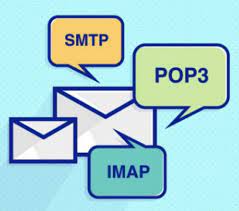


POP3
POP3 is Post Office Protocol version 3. Typically, you use an email client such as Outlook or Thunderbird to download messages from your server. Once downloaded, these messages are deleted from the server. POP3 is a single device application.
The client POP3 software is installed on the receiver’s computer and the server POP3 software is installed on the mail server.
POP3 is described in RFC 1939 and it uses well-known TCP port 110. The communication procedure uses ASCII characters. POP3 begins when the user starts the mail reader. The mail reader calls up the ISP (or mail server) and establishes a TCP connection with the message transfer agent at port 110.
Once the connection has been established, the POP3 protocol goes through three states in sequence
IMAP
IMAP is Internet Messaging Access Protocol. IMAP is also a protocol to receive emails, but the difference is that IMAP syncs messages across all your devices. It is server-centric. Thus, you can see that IMAP is more flexible than POP3.
IMAP offers you:
SMTP
SMTP or Simple Mail Transfer Protocol is a standard for sending email messages. SMTP is what you call a Push protocol.
The SMTP model is of two types
The end-to-end model is used to communicate between different organizations whereas the store and forward method is used within an organization. An SMTP client who wants to send the mail will contact the destination’s host SMTP directly to send the mail to the destination. The SMTP server will keep the mail to itself until it is successfully copied to the receiver’s SMTP.
The client SMTP is the one that initiates the session let us call it client- SMTP and the server SMTP is the one that responds to the session request and let us call it receiver-SMTP. The client- SMTP will start the session and the receiver-SMTP will respond to the request.
Note
If you set up POP3, IMAP, or SMTP, you have to configure the port and protocol of your mail client. (no need if you are using Webmail). Typically, POP3 is port 110 (SLL/TLS encrypted connection uses port 995), IMAP is port number 143 (SLL/TLS encrypted connection uses port 993) and SMTP uses port number 25 (SSL/TLS encrypted connection uses port 465).
However, check with your ISP (Internet Service Provider) and/or your domain registrar.
Hope this helps.
God Bless!
There are 5 planes that we all live in. They are: Physical Plane Vital Plane…
Change is the only constant, somebody said. Everything around us changes, including ourselves. We lose…
The past is a distant memory, and the future is a possibility. What if I…
Shiva is not a concept. He is a phenomenon. He is the first yogi, called…
Still remember the heyday of Computing - the 60's and the 70's when the input…
You attract not what you want, but what you are. Every second your vibration level…
This website uses cookies.